Donate Now
Contribute to history, culture, and art in Ybor City. We need additional resources to improve the mural with lighting and a viewing kiosk, as well as support other public art projects that enhance the historic district.
More About the Project

|

Mural Legend
Every section of the mural tells a unique story about the people, the history, and
the culture of Ybor City.
Click this image below to view the full size image (file size: 13.4 MB).

An American Journey
The Legacy of Ybor City and Tampa
The public/private Ybor City mural project was designed and produced under the artistic
direction of muralist Michael Parker, supported by community volunteers and art
students from Hillsborough Community College Ybor Campus. The mural covers 12,000
square feet of surface area, the largest outdoor original artwork in the state of
Florida.
The design incorporates three integrating themes and six individual messages reflecting
the experience of the Ybor National Historic Landmark District, past and present.
The integrating themes are:
The Journey through Life
At the far left, an immigrant family stands at the beginning of their American journey.
An uncertain starting point of great hope and great risk. As the viewer scans from
left to right, the scenes accelerate in tempo and complexity, as does life, to a
critical point at the center where past and present pressures and destinies merge.
Continuing right of the center point carries the viewer through a reflective phase
and ultimately to the peace and security of home and family.
The Conflict between Tradition and Progress
Many of the people depicted in the mural faced hard choices between clinging to
the past or reaching for tomorrow. The internal conflicts include the tension between
Spanish and Cuban citizens during the Cuban Revolution, the struggle for equality
among the black population, the changing role of women, the class conflict between
management and working class and the desire to stay near home while at the same
time hungering for new experience and opportunity.
The American Experience
Throughout this mural shine the values of our nation – a place people from many
nations came to enjoy freedom – a place people from many nations came to find economic
opportunity – and a place people from many nations came to secure hope for future
generations. There is no better example of successful assimilation of vastly different
cultures within the United States. This is a legacy to treasure.
Note that the most prominent faces in the design are two young women. The artist
and the community who contributed their thoughts felt strongly that the piece illustrate
that our rich heritage is more than a story hidden in books or museums and cataloged
as “the past.” It is rather a foundation upon which we stand today – a very human
story continuing to unfold through the living, as can be seen just a few blocks
to the north in the everyday activities of Ybor City, our National Historic Landmark
District.
Section A: Opportunity! The start point for our journey into an
uncertain future
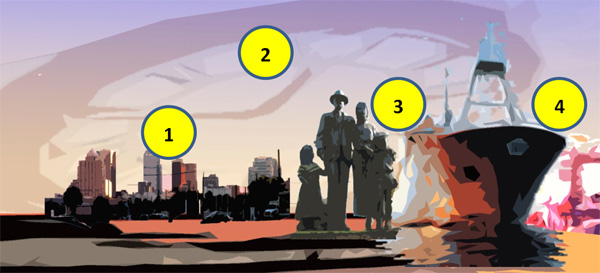
- Tampa Skyline: The modern skyline at the left extreme of the mural
is an echo of the actual Tampa skyline about a mile to the West. It represents the
inseparability of greater Tampa with Ybor City. It was the opportunity to work in
Ybor’s cigar factories that brought thousands of immigrants
to fuel regional development. As Tampa moves into the future, the historic district
will remain an integral part of the downtown area, connected to Channelside via
Adamo Drive.
- El Reloj: This iconic clock regulated activity within the Ybor
City community. It drove the rhythms of the factories as well as the cycle of everyday
life. Today the restored clock tower graces the top of the at 2701 North 16th Street (just north of I-4). In this
mural El Reloj represents the patterns of a working class town (or the challenges
of regimentation in a Latin community!) as well as the urgency associated with knowing
there are only so many hours in a day – or a life.
- Immigrant Family: The grouping represents the vulnerability,
anxiety and optimism of those who left everything familiar behind in the hopes of
building a better life. The family represents a fundamental desire of all mankind
for freedom, security and opportunity -- the promise of America. The image is taken
from the in Centennial Park across
from the on 8th Ave.
- Ship: The ship represents globalization from the early 1800’s,
a sweeping evolution that has accelerated to the present day. As travel increased,
cultures began blending more, foreign wars involved more nations and economies and
markets became more interdependent. Ybor City and Tampa were discovered by an international
fruit company from New York in search of . The cigar
industry that made Ybor City and Tampa the Cigar Capital of the world was based
on leaf arriving from Cuba by ship, with finished products departing by train. Teddy
Roosevelt’s staged from Tampa on the way
to Cuba because of the ship/train convergence. Across the street from this mural
is the – currently the largest cargo port
in the state of Florida.
Section B: Diversity, Assimilation and Harmony
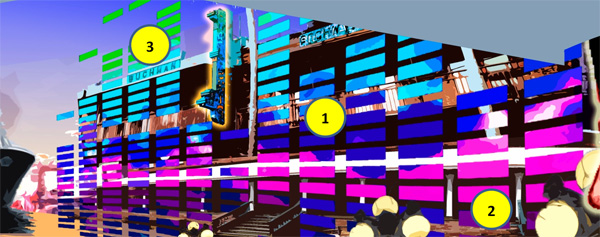 Nowhere else in the United States can we find as compelling a story of the blending
of so many different people and cultures into one society. While individual traditions
were preserved in the different social clubs and families, everyone coalesced into
one community on the floors of factories, city streets and dance halls. This tradition
of acceptance and tolerance continues today on the streets of Ybor City.
Nowhere else in the United States can we find as compelling a story of the blending
of so many different people and cultures into one society. While individual traditions
were preserved in the different social clubs and families, everyone coalesced into
one community on the floors of factories, city streets and dance halls. This tradition
of acceptance and tolerance continues today on the streets of Ybor City.
- Equalizer: The bars of the equalizer represent the many different
cultures, races, and personalities that blended on the streets of Ybor City. This
is often called the “paella” signature of Tampa’s Latin
Quarter. The equalizer also emphasizes the strong role that music and the arts played
in spicing up life in a working class town. Music and dancing were the attraction
to the chaperoned events regularly conducted within the individual social clubs.
The Cuban, Italian, Centro Asturiano and Marti-Maceo social clubs
in Ybor City are still operating and open to the public.
- Trademark Ybor City Streetlights: The line of streetlights illustrates
the “paseo” or walk through city streets that was a tradition combining fresh air
and exercise with the opportunity to mingle with one’s neighbors. The streetlight
design remains today as a trademark image of Ybor City. The “Septima Walk”
along 7th Avenue and appeal of the “paseo” or café atmosphere remains a signature
of Ybor City, in various configurations depending on the time of day or night.
- European Presence: Although considered the “Latin Quarter,” much
of Ybor City’s retail activity was run by Europeans from Germany, Romania, Hungary
and other countries. These immigrants, largely of the Jewish faith, operated the
groceries, haberdasheries, furnishing stores and eateries of the industrial town.
Many buildings, such as the building depicted
here, still reflect that heritage. Descendants through generations remain actively
engaged in the business of the district.
Section C: Each of Us Can Achieve – Adversity Overcome in the Past,
Present, and Future
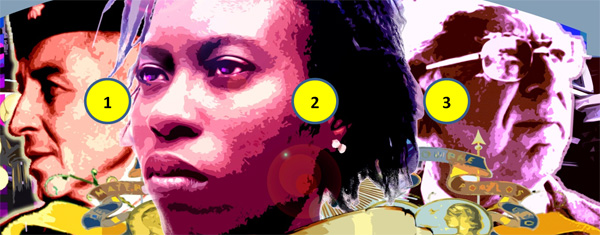
- : Dr. Adamo is the American hero for which
Highway 60 (1st Avenue) is named. Born in Ybor City to an immigrant Italian family
in 1893, Frank worked in the cigar factories before ultimately becoming a doctor
and joining the Army. He survived three years of captivity in Japanese POW camps
after the fall of Corregidor during WWII and is credited with a treatment for gangrene
that saved countless limbs and lives. Dr. Frank Adamo epitomizes compassion and
service and is a historic example of what can be achieved within a lifetime with
hard work and sacrifice. His gaze is to the left of the image – to our past.
- The Face of Today’s Challenges: The center profile illustrates
the humanity, compassion and service exemplified by Frank Adamo in a contemporary
context. Today’s sons and daughters of Tampa are reaching for education at Hillsborough
Community College, the University of South Florida, the University of Tampa and
other local academic and tech training centers. Many serve the community through
outreach programs and community service organizations. A talented few contributed
to design and produce this mural. This image represents today’s youth working to
make the most of their talent and potential.
- : “Mayor” Pizzo illustrates the power of vision and leadership
to inspire citizens to rise above their current situation and reach for a better
tomorrow. Known best for his love of Ybor City and vivid description of what Tampa
could become in the future, Tony Pizzo was role model and motivator for people aspiring
to improve themselves and their community. Read his 1952 vision
for Ybor City at www.yborartproject.com . “Mayor” Pizzo looks off to the East –
toward our future.
Section D: Personalities of Ybor City – A Salute to Our Heritage

This section highlights exceptional personalities who gave form and flavor to the
Cigar City. The images are outlines rather than full portraits to suggest that although
these lives have passed, their impact endures. Some were craftsmen, some were business
people, some were community leaders and some were all. Those left of center were
“Builders and Designers.” Those to the right of center were “Activists and Artists.”
Surrounding the images are the traditional bricks and hexagonal stones of Ybor and
the word collage comes from the strongest themes associated with Ybor City in current
social media. The central figure is a collage of historic cigar labels and resembles
the scales of justice – an illustration of the decisions we all have to make in
the critical central time of our lives when we choose our destiny.
There are 11 personalities represented here. The choice of who to honor was undertaken
through a series of community workshops and student research and ultimately determined
by the artist. The work is not a formal history but rather an artistic expression
combining elements of history and past/present human experience.
There are many other individuals worthy of illustration within the composition,
but only a handful could be included as representatives of the many who gave our
community form, substance and humanity. Surely many lively debates will center on
the “final 11” and the many other notable personalities equally deserving of the
honor.
There are three complementary segments of this section. Each are highlighted in
the images that follow.
Section D-1: Builders and Designers

- : Beloved “First Lady of Ybor City,” Adela was heir
to the family business, graduate of
the Julliard School of Music and lifelong champion of civility and culture in the
historic district. Born just a few blocks away from the restaurant, Adela achieved
prominence as Founder of the Ballet Folklorico, Washington
Press Club Hispanic Woman of the Year in 1992, three-time president of the and president of the . The Columbia remains an Ybor institution.
- Dr. Henry Fernandez: Five-term President of Ybor Chamber of Commerce
and champion of Ybor City as a tourist destination. In 1957, after noting, “we have
one great attraction that has gone unnoticed and undeveloped … and that is Ybor
City,” he led a team to New Orleans to discuss historic tourism with the Vieux Caree Commission. Subsequent to this trip, he garnered support
from Florida Representative Sam Gibbons to create the
(BLC) in Tampa. The BLC remains the protector of the architectural integrity of
Ybor City today.
- : Founder of ,
Arturo embodies the “never say die” persistence of “Cigar City” pioneers facing
economic, political and natural disasters. Forced to rebuild repeatedly after depression,
war and fire ruined the business he began in 1912, the Fuente family remains prosperous
today in the US and Dominican Republic, with headquarters now in a historic Ybor
City cigar building.
- : Cigar industry pioneer along with New York partner
Serafin Sanchez and fellow Ybor pioneer Vicente Martinez Ybor. Holder of Permit
#1, Haya produced the very first cigar in an Ybor factory on April 13, 1886. He
helped found and served as President of Ybor City’s first cultural social club,
the . The Haya factory no longer exists
but the Centro Español, rebuilt after a fire in 1912, remains.
- : Civil engineer and close associate and friend
of Vicente Martinez-Ybor who designed the layout of Ybor City and for the cigar industry. Initially impressed with the Tampa
area as perfect for the guava fruit industry, Gutierrez saw the value of a deep
port, tropical climate, rail access and proximity to Cuba as key attributes of a
cigar manufacturing center. Ybor and Haya, among others, agreed.
- : Venerable “Founder of Ybor City.” Decisive
and aggressive, Ybor bought land, built his factory, started a land development
office and founded the , where notables
such as Presidents Theodore Roosevelt and Warren Harding visited. Ybor’s cigar factory,
the Cherokee Club and land office still stand (Scientology Center, El Pasaje and
, respectively).
Section D-2: The Central Figure
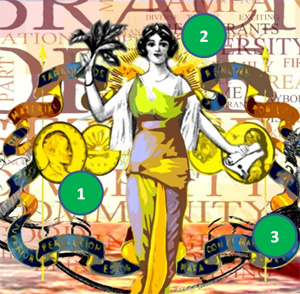 Commanding this section is a female figure with arms extended as if to represent
the scales of justice. Her pose symbolizes choices we weigh in making life decisions.
The handful of tobacco leaves in her right hand represent labor, industry, material
wealth and possession - the security of home and employment. The scroll in her left
hand represents education, aspiration, art, creativity, and exploration - growth,
adventure and change. She is surrounded by words that are most often used today
in conversation and social media about Ybor City. Elements of three different Ybor
City cigar labels comprise this section:
Commanding this section is a female figure with arms extended as if to represent
the scales of justice. Her pose symbolizes choices we weigh in making life decisions.
The handful of tobacco leaves in her right hand represent labor, industry, material
wealth and possession - the security of home and employment. The scroll in her left
hand represents education, aspiration, art, creativity, and exploration - growth,
adventure and change. She is surrounded by words that are most often used today
in conversation and social media about Ybor City. Elements of three different Ybor
City cigar labels comprise this section:
- : The four coins were on the label of the first cigar
made in Ybor City.
- : Founded in 1902, the Hav-A-Tampa brand came to symbolize
the fusion of Tampa with the cigar industry. The company employed over 500 employees
until closing in 2009, when federal taxes increased 800%. The Hav-A-Tampa cigar
is still being produced – in Puerto Rico. The last remaining large scale cigar manufacturing
company in Tampa is J.C. Newman Cigar Co. with about 150 employees. Executive VP
Bobby Newman describes his company as, “last of the Mohicans.”
- Gonzalez Habano: Contemporary label for Master Roller
Wallace Reyes in Ybor City. Wallace recently entered the Guinness
Book of World records for producing the world’s longest cigar. He may be found today
in Ybor City where he hand crafts his cigars and lectures on the history of cigar
making and Ybor City.
Section D-3: Activists and Artists
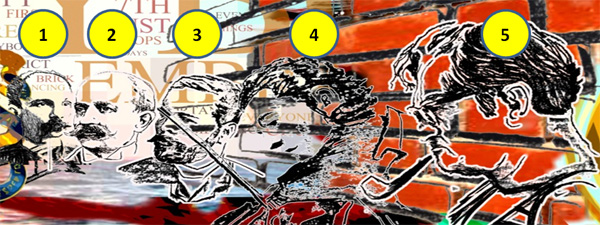
- : Firebrand revolutionary and orator known as the “George
Washington of Cuba.” Marti visited Tampa urging support for Cuban independence over
20 times and spoke to crowds from the steps of Ybor cigar factories. Although a
passionate subject, workers of both Spanish and Cuban descent set their differences
aside in the community and factory floor – they were American first and foremost.
Today a stands across the street from the
factory where Marti spoke, on the site of the Pedroso home where he stayed on visits.
- : Vicente Martinez-Ybor brought industry and Gavino
Gutierrez planned the city, but Manrara was the motivating force to develop the
district. With Ybor’s help, he established the Ybor City Land and Improvement
Company (which then became the Gonzalez clinic and is now the
Don Vicente Hotel). Under his leadership the company built houses and factories
and worked incentive packages with the Tampa Board of Trade to entice investment.
His innovative efforts provided the spark to turn vision and potential into a thriving
industrial city.
- : Often overlooked, Maceo was second-in-command
of the Cuban Revolutionary Army. A professional soldier, Maceo stood as role model
and hero for black Cubans within Tampa. He illustrates that within a society of
mixed race and culture; there can be cohesion and shared leadership despite prejudice.
It is a story important to our heritage as a city and nation. Maceo’s heroism and
the solidarity of white and black Cuban patriots are themes preserved today by the
La Unión Martí-Maceo social club still operating in Ybor
City.
- : Cesar, Adela’s husband, was a professional violinist,
band leader and activist for Ybor as well as Cuban humanitarian issues. His passion
helped build the Gonzmart family business into the large corporation of today, despite
skepticism from many about his artistic nature. Cesar’s passion for Ybor led to
the founding of the current Ybor City Museum and several aggressive community development
plans. He represents both the activist and artistic nature of many who gave vitality
and flair to Ybor City and Tampa.
- Frank Costantino: Frank represents the pride, skill and compassion
of the craftsmen who built Tampa. Born in Ybor after his parents emigrated from
Sicily, Frank took up his father’s stone cutting business. A “man of tradition”
as well as a humanist who took in the homeless and orphaned. Frank’s life illustrates
the ethic of hard work and high standards. These traits, much like the stone Frank
worked, form the foundation of Ybor, Tampa and our national economy.
Section E: Triumph of the Human Spirit and Power of Free Speech
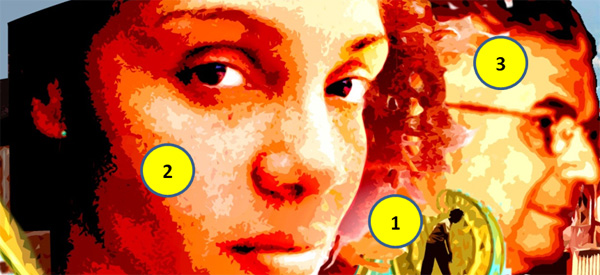 The previous section highlighted “doers” – those who brought industry to Tampa Bay
and those who built the community around it. This section recognizes less tangible
human factors that move a free nation forward and are so deeply interwoven in the
heritage of Ybor City.
The previous section highlighted “doers” – those who brought industry to Tampa Bay
and those who built the community around it. This section recognizes less tangible
human factors that move a free nation forward and are so deeply interwoven in the
heritage of Ybor City.
- Paulina Pedroso: Jose Marti visited Ybor City to speak of a free
Cuba from the steps of our cigar factories. During those visits he stayed with the
Pedroso family. The food was good, the hospitality warm and the security comforting.
On the site of the old Pedroso home now stands a monument to Marti. Paulina is included
in the mural to emphasize the strong role of women in Ybor’s history. Her legacy
covers her care for the “father of Cuban independence” as well as a colorful vignette
of her taking off her petticoats and tossing them at workers she chastised for failing
to support the revolution.
- The Face of Today’s Youth: Mirroring the contemporary face at the
other end of the mural, this profile communicates the spirit and resolve of new
generations of citizens overcoming gender, socio/economic and racial stereotypes.
The profile illustrates that the spirit of Paulina lives in the present. Strong
people, both men and women, will define our future as in our past. Of all the portraits,
this one has the greatest direct eye contact. Her message is simple – “if I can
do it so can you.”
- : Victoriano was a “Lector”
on the floors of Ybor City cigar factories. The Lector was a combination of celebrity,
actor, orator, newsman and editorialist who read novels, news and political commentary
to the workers. Victoriano represents the power of ideas and the exercise of free
speech that generated controversy as well as cohesiveness among citizens of many
races and cultures. His legacy lives on in the
newspaper he founded - the nation’s only tri-lingual newspaper and oldest continuously
operating minority-owned publication in Florida. His gaze is to the right of the
image, toward the future.
Section F: New Horizons
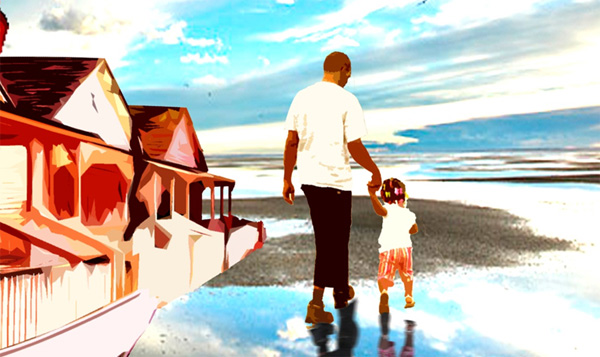
The right end of the mural depicts a father and his daughter moving toward the future.
The traditional casitas of Ybor are seen at the left,
and the sands of a beach and a new horizon lie ahead. There is no story to paint
in the space in front of this family – just sand, water and sky. Much like the immigrant
family at the far left end of the mural, these people know from where they came
and what they want from life but there is much unknown about the future.
While times are different, we share the same desire for the dignity, opportunity,
and privilege of living in a free country that brought waves of immigrants to Ybor
City and Tampa. We are connected through time as a nation of dreams and hard work,
where all are encouraged to make the most of their talent to make a better life
for themselves and those they care about.
This is the real story of Ybor City, National Historic Landmark District, proud
historic foundation of Tampa and shining example of the American Dream.
|